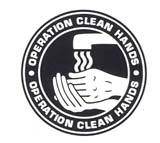
American Society for Microbiology
|
"Don't forget to wash your hands" is a hygiene topic brought to public attention by the English surgeon John Lister during the nineteenth century. The subject was often addressed in the medical literature of the day, as well as in newspapers and magazines read by the general public. As the twentieth century comes to a close, handwashing remains one of the single most effective methods of preventing the transmission of potential bacterial and viral pathogens. We would expect that hand washing would be a universally accepted practice and an integral component of the tradition and ritual of infection prevention among teachers and health care workers; however, it remains a source of major concern.
The problem may be more acute for children with physical and sensory disabilities. They have a higher frequency of colds, influenza, and other infections than average children, thus resulting in higher rates of school absenteeism and the seeking of medical assistance (Journal of School Health, March, 1992).
The fundamental behavior of handwashing was learned by most of us from our parents before we understood the words. In schools, teachers continually reinforce the practice. However, despite our training and the medical evidence, compliance with handwashing standards established by the Centers for Disease Control (CDC) is poor. Studies indicate that less than half of all contacts between health care professionals and indivduals known to have infectious diseases are preceded or followed by handwashing (The American Journal of Occupational Therapy, June, 1993). "Hand washing in this country has become all but a lost art," laments Dr. Michael Osterholm, who chairs the American Society for Microbiology's(ASM) Committee on Public Health (The Boston Globe, September, 1996).
Dr. Timothy Johnson, ABC News Medical Editor, commented on the program 20/20 (October 4, 1996) that many experts concur that handwashing is a lesson too many of us have long since forgotten. According to Johnson, the failure to comply with this basic act of hygiene produces alarming results. He noted that "Today, infectious diseases are growing with a vengeance. In just 12 years, they increased by 58%, rising from the fifth to the third leading killer of Americans."
Inadequate handwashing practices are not solely the result of ignorance or a lack of information. The discrepancies between recommended and practiced hand washing behavior include a variety of factors: (a) inconvenient, inadequate, or dirty facilities, (b) perceived low risk of infection to self, (c) a behavior not practiced by peers, (d) deemed as detrimental to one's skin, (e) time constraints, and (f) shoddy personal habits.
The technique of washing one's hands is as important as the frequency. CDC recommend soap (preferably antibacterial) and the use of hot running water for removing organisms from the hands. Additional suggestions include:
Remember, fabric towels are effective only if they are used once. Also, a hand drier's filter can become saturated with bacteria after prolonged use-bacteria, therefore, may be blown out in the airstream and over the hands of the user.
It has become common practice to wear latex or vinyl gloves as an alternative to washing hands. Yet, CDC have stated that wearing gloves alone does not replace hand washing and that handwashing should always be a required procedure of universal health precautions after removing gloves (Morbidity and Mortality Weekly Report, June 24, 1988).
Although gloves provide a barrier, they are not completely impermeable and the protective effect of gloves can be reduced with wear. Moreover, organisms on the hand multiply rapidly inside the warm, moist environment of the glove, even when no external contamination has occurred (American JournalofNursing, July, 1989).
Disease-causing germs can enter your body when your unwashed hands touch your nose, mouth, and open wounds. But how often do you wash your hands? A recent survey ("Americans Caught Dirty Handed" by ASM, 1996) found that 94% of respondents say that they always wash their hands after going to the bathroom. However, observations in public restrooms indicate that only 68% of adults do so. Handwashing, when taken seriously, can help us stay healthy. What strategies has your workplace implemented to encourage handwashing to reduce the spread of germs and infection? Are you doing your part to assure a healthy work environment?